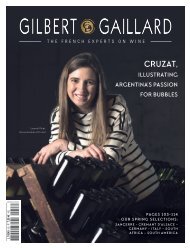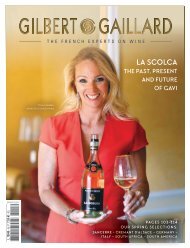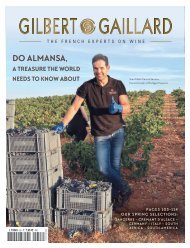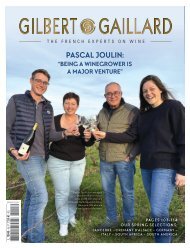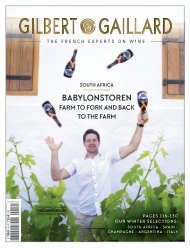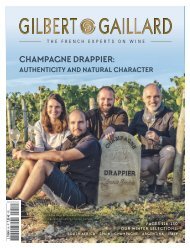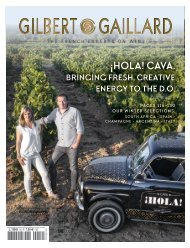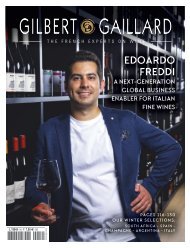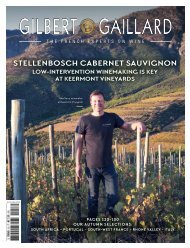You also want an ePaper? Increase the reach of your titles
YUMPU automatically turns print PDFs into web optimized ePapers that Google loves.
BORDEAUX<br />
APPELLATION<br />
Until the turn of the 20 th century, Castillon produced<br />
both red and white wine, but whites have now<br />
exited the appellation. Six grape varieties can be<br />
used – Merlot is the undisputed king of the varietal<br />
range, often blended with a little Cabernet Franc or<br />
even Cabernet-Sauvignon or Cot (the local name<br />
for Malbec). Occasionally, there is even a dash of<br />
Petit Verdot or Carmenere, but their share cannot<br />
be higher than 15%.<br />
Although Castillon was previously a stand-alone<br />
appellation, the wines have now technically been<br />
subsumed into the Côtes de Bordeaux appellation,<br />
as a complementary designation. In fact, production<br />
specifications – maximum yield and minimum<br />
level of ripeness for example – are slightly more<br />
quality-focused than for plain Côtes de Bordeaux.<br />
COPING WITH CLIMATE CHANGE<br />
THE VINEYARDS AT CHÂTEAU BRÉHAT<br />
As in most wine regions around the world, climate<br />
disruptions in Castillon have both a short and longterm<br />
impact. Over the long term, higher temperatures<br />
promote greater ripeness in the grape flesh,<br />
with more sugar content and lower acidity. This<br />
is particularly tangible with Merlot, due to its<br />
thin skin. Consequently, the wines display higher<br />
alcohol content and can lose some of their freshness.<br />
To cope with these changes, winegrowers have<br />
responded in different ways. For some time now,<br />
they have been choosing cooler soils for Merlot, and<br />
have started increasing the share of other grape<br />
varieties in blends. Also, they have been harvesting<br />
earlier – in 2022, the harvest kicked off at the start<br />
of September. Lastly, total acidity in the wines is<br />
corrected, as with most wines from the South, by<br />
adding some tartaric acid. The acid occurs naturally<br />
in the grapes.<br />
All of this produces concentrated wines displaying a<br />
dark ruby hue, with notes of ripe red fruits, prunes,<br />
leather and game. However, in anticipation of continued<br />
global warming, a more drastic measure has<br />
been decided – very little Merlot is now going into<br />
the ground.<br />
In the short term, heat waves, rain and sudden<br />
hailstorms are having different types of effect.<br />
86 AUTUMN 2022 • GILBERT & GAILLARD - THE FRENCH EXPERTS ON WINE



